The Synergy between Nuclear Magnetic Resonance and Density Functional Theory Calculations
Abstract
1. Introduction
2. Results and Discussion
2.1. DFT Calculations
2.2. XH Positions
2.3. Assignments
2.4. Stereochemistry
2.5. Isotope Effects
2.6. Tautomerism
2.7. Geometric Isomers
2.8. Coupling Constants
2.9. Ring Current and Anisotropy Effects
2.10. Charged Species
2.11. Chemical Libraries
2.12. Solid State
3. Conclusions
Funding
Institutional Review Board Statement
Informed Consent Statement
Data Availability Statement
Acknowledgments
Conflicts of Interest
References
- Rzepiela, K.; Buczek, A.; Kupka, T.; Broda, M.A. Factors Governing the Chemical Stability and NMR Parameters of Uracil Tautomers and Its 5-Halogen Derivatives. Molecules 2020, 25, 3931. [Google Scholar] [CrossRef] [PubMed]
- Holtomo, O.; Nsangou, M.; Motapon, O. Basis set dependence of 1H–X spin–spin coupling constants in non-empirical pure DFT framework, X = 1H, 13C, 19F, 35Cl: Case of CHCl=CH–CF3 stereoisomers. AIP Adv. 2021, 11, 035113. [Google Scholar] [CrossRef]
- Antonov, L. (Ed.) Tautomerism: Concepts and Applications in Science and Technology; Wiley-VCH Verlag: Weinheim, Germany, 2016. [Google Scholar]
- Chhetri, B.K.; Lavoie, S.; Sweeney-Jones, A.M.; Kubanek, J. Recent trends in the structural revision of natural products. Nat. Prod. Rep. 2018, 35, 514–531. [Google Scholar] [CrossRef] [PubMed]
- Antonov, L. (Ed.) Tautomerism: Methods and Theories; Wiley-VCH Verlag GmbH: Weinheim, Germany, 2014. [Google Scholar]
- Bazrafshan, M.; Vakili, M.; Tayyari, S.F.; Kamounah, F.S.; Hansen, P.E.; Shiri, A. Synthesis, molecular structure, conformational, and intramolecular hydrogen bond strength of ethyl 3-amino-2-butenoate and its N-Me, N-Ph, and N-Benzyl derivatives; an experimental and theoretical study. J. Mol. Struct. 2023, 1274, 34479. [Google Scholar] [CrossRef]
- Ditchfield, R. Self-consistent perturbation theory of diamagnetism. 1. A Gauge-invariant LCAO method for N.M.R. chemical shifts. Mol. Phys. 1974, 27, 789–807. [Google Scholar] [CrossRef]
- Wolinski, K.; Hilton, F.F.; Pulay, P. Efficient implementation of the gauge-independent atomic orbital method for NMR chemical shift calculations. J. Am. Chem. Soc. 1990, 112, 8251–8260. [Google Scholar] [CrossRef]
- Tomasi, J.; Persico, M. Molecular interactions in solution: An overview of methods based on continuous distributions of the solvent. Chem. Rev. 1994, 94, 2027–2094. [Google Scholar] [CrossRef]
- Kutateladze, A.G.; Reddy, D.S. High-Throughput In Silico Structure Validation and Revision of Halogenated Natural Products Is Enabled by Parametric Corrections to DFT-Computed 13C NMR Chemical Shifts and Spin–Spin Coupling Constants. J. Org. Chem. 2017, 82, 3368–3381. [Google Scholar] [CrossRef]
- Kupka, T. Theory and Computation of Nuclear Shielding. In Nuclear Magnetic Resonance; Hodgkinson, P., Sauri, J., Eds.; Royal Society of Chemistry: London, UK, 2022; Volume 48. [Google Scholar]
- Grimblat, N.; Sarotti, A.M. Computational Chemistry to the Rescue: Modern Toolboxes for the Assignment of Complex Molecules by GIAO NMR Calculations. Chem. A Eur. J. 2016, 22, 12246–12261. [Google Scholar] [CrossRef]
- Beran, G.J.O. Calculating Nuclear Magnetic Resonance Chemical Shifts from Density Functional Theory: A Primer. eMagRes 2019, 8, 215–226. [Google Scholar]
- Bagno, A.; Rastrelli, F.; Saielli, G. Toward the Complete Prediction of the 1H and 13C NMR Spectra of Complex Organic Molecules by DFT Methods: Application to Natural Substances. Chem. Eur. J. 2006, 12, 5514–5525. [Google Scholar] [CrossRef] [PubMed]
- De Albuquerque, A.C.F.; Ribeiro, D.J.; de Amorim, M.B. Structural determination of complex natural products by quantum mechanical calculations of 13C NMR chemical shifts: Development of a parameterized protocol for terpenes. J. Mol. Model. 2016, 22, 183. [Google Scholar] [CrossRef]
- Elyashberg, M.; Tyagarajan, S.; Mandal, M.; Buevich, A.V. Enhancing Efficiency of Natural Product Structure Revision: Leveraging CASE and DFT over Total Synthesis. Molecules 2023, 28, 3796. [Google Scholar] [CrossRef] [PubMed]
- Siskos, M.G.; Choudhary, M.I.; Gerothanassis, I.P. Hydrogen Atomic Positions of O–H···O Hydrogen Bonds in Solution and in the Solid State: The Synergy of Quantum Chemical Calculations with 1H-NMR Chemical Shifts and X-ray Diffraction Methods. Molecules 2017, 22, 415. [Google Scholar] [CrossRef] [PubMed]
- Mari, S.H.; Varras, P.C.; Atia-tul-Wahab; Choudhary, I.M.; Siskos, M.G.; Gerothanassis., I.P. Solvent-Dependent Structures of Natural Products Based on the Combined Use of DFT Calculations and 1H-NMR Chemical Shifts. Molecules 2019, 24, 2290. [Google Scholar] [CrossRef] [PubMed]
- Abildgaard, J.; LiWang, A.; Manalo, M.N.; Hansen, P.E. Peptide Deuterium Isotope Effects on Backbone 15N Chemical Shifts in Proteins. J. Biol. NMR 2009, 44, 119–124. [Google Scholar] [CrossRef] [PubMed][Green Version]
- Zhu, H.; Wang, Y.; Nafie, L.A. Computational methods and points for attention in absolute configuration determination. Front. Nat. Prod. 2023, 1, 1086897. [Google Scholar] [CrossRef]
- Ratnayake, R.; Wikramratne, N. A novel Tetracyclic Sesquiterpene from the Genus Hortonia. Ceylon J. Sci. 2017, 46, 115–118. [Google Scholar] [CrossRef][Green Version]
- Lauro, G.; Das, P.; Riccio, R.; Reddy, D.S.; Bifulco, G. DFT/NMR Approach for the Configuration Assignment of Groups of Stereoisomers by the Combination and Comparison of Experimental and Predicted Sets of Data. J. Org. Chem. 2020, 85, 3297–3306. [Google Scholar] [CrossRef]
- Das, P.; Babbar, P.; Malhotra, N.; Sharma, M.; Jachak, G.R.; Gonnade, R.G.; Shanmugam, D.; Harlos, K.; Yogavel, M.; Sharma, A.; et al. Specific Stereoisomeric Conformations Determine the Drug Potency of Cladosporin Scaffold against Malarial Parasite. J. Med. Chem. 2018, 61, 5664–5678. [Google Scholar] [CrossRef]
- Hansen, P.E. Isotope Effects on Chemical shifts of small molecules. Molecules 2022, 27, 2405. [Google Scholar] [CrossRef] [PubMed]
- Jameson, C.J.; Osten, H.-J. The NMR isotope shift in polyatomic molecules. Estimation of the dynamic factors. J. Chem. Phys. 1984, 81, 4300–4305. [Google Scholar] [CrossRef]
- Elias, R.S.; Saeed, B.A.; Kamounah, F.S.; Duus, F.; Hansen, P.E. Strong Intramolecular Hydrogen Bonds and steric Effects. A NMR and Computational Study. Magn. Reson. Chem. 2020, 58, 154–162. [Google Scholar] [CrossRef] [PubMed]
- Saeed, B.A.; Elias, R.S.; Kamounah, F.S.; Hansen, P.E. A NMR, MP2 and DFT Study of Thiophenoxyketenimines (o-ThioSchiff bases). Magn. Reson. Chem. 2018, 56, 172–182. [Google Scholar] [CrossRef]
- Hansen, P.E.; Darugar, V.; Vakili, M.; Kamounah, F.S. Tautomerism of pyridinylbutane-1,3-diones: An NMR and DFT study. Magn. Reson. Chem. 2023, 61, 356–362. [Google Scholar] [CrossRef] [PubMed]
- Cmoch, P.; Krzeczyński, P.; Leś, A. Multinuclear NMR Measurements and DFT Calculations for Capecitabine Tautomeric form Assignment in a Solution. Molecules 2018, 23, 161. [Google Scholar] [CrossRef] [PubMed]
- El-Demerdash, S.H.; Halim, S.A.; El-Nahas, A.M.; El-Meligy, A.B. A density functional theory study of the molecular structure, reactivity, and spectroscopic properties of 2-(2-mercaptophenyl)-1-azaazulene tautomers and rotamers. Sci. Rep. 2023, 13, 15626. [Google Scholar] [CrossRef]
- Mohamed, T.A.; Shaaban, I.A.; Soliman, U.A.; Zoghaib, W.M. 2-Hydroxy-5-nitropyridine and 5-nitro-2-pyridone: Tautomerism, infrared, Raman, and NMR spectral interpretations, normal coordinate analysis, and DFT calculations. J. Chin. Chem. Soc. 2021, 68, 1863–1879. [Google Scholar] [CrossRef]
- Elguero, J.; Alkorta, I. A DFT study of the tautomerism of 1H-benzo[de]cinnolines and their protonated forms. Theor. Chem. Accounts 2022, 141, 26. [Google Scholar] [CrossRef]
- Claramunt, R.M.; López, C.; Sanz, D.; Elguero, J.; Alkorta, I. Determination of the tautomerism of albendazole desmotropes using solution and solid state NMR together with DFT theoretical calculations, both energies and chemical shifts. J. Mol. Struct. 2022, 1261, 132883. [Google Scholar] [CrossRef]
- Agatonovic-Kustrin, S.; Glass, B.D.; Mangan, M.; Smithson, J. Analysing the crystal purity of mebendazole raw material and its stability in a suspension formulation. Int. J. Pharm. 2008, 361, 245–250. [Google Scholar] [CrossRef] [PubMed]
- Bravetti, F.; Bordignon, S.; Alig, E.; Eisenbeil, D.; Fink, L.; Nervi, C.; Gobetto, R.; Schmidt, M.U.; Chierotti, M.R. Solid-State NMR-Driven Crystal Structure Prediction of Molecular Crystals: The Case of Mebendazole. Chem. Eur. J. 2022, 28, e202103589. [Google Scholar] [CrossRef] [PubMed]
- Hansen, P.E.; Kamounah, F.S. Multiple Intramolecular Hydrogen Bonding in large Biomolecules. DFT Calculations and Deuterium Isotope Effects on 13C chemical shifts as a tool in structural studies. Chemistry 2023, 5, 1317–1328. [Google Scholar] [CrossRef]
- Ditchfield, R.; Hehre, W.J.; Pople, J.A. Self-Consistent Molecular-Orbital Methods. IX. An Extended Gaussian-Type Basis for Molecular-Orbital Studies of Organic Molecules. J. Chem. Phys. 1971, 54, 724–728. [Google Scholar] [CrossRef]
- Oh, J.; Quan, K.T.; Lee, J.S.; Park, I.; Kim, C.S.; Ferreira, D.; Thuong, P.T.; Kim, Y.H.; Na, M. NMR-Based Investigation of Hydrogen Bonding in a Dihydroanthracen-1(4H)one from Rubia philippinensis and Its Soluble Epoxide Hydrolase Inhibitory Potential. J. Nat. Prod. 2018, 81, 2429–2435. [Google Scholar] [CrossRef] [PubMed]
- Hansen, P.E. NMR of natural products as potential drugs. Molecules 2021, 26, 3763. [Google Scholar] [CrossRef] [PubMed]
- Safi, Z.S.; Wazzan, N. DFT calculations of 1H- and 13C-NMR chemical shifts of 3-methyl-1-phenyl-4-(phenyldiazenyl)-1H-pyrazol-5-amine in solution. Sci. Rep. 2022, 12, 17798. [Google Scholar] [CrossRef]
- Venianakis, T.; Oikonomaki, C.; Siskos, M.G.; Primikyri, A.; Gerothanassis, I.P. DFT Calculations of 1H NMR Chemical Shifts of Geometric Isomers of Conjugated Linolenic Acids, Hexadecatrienyl Pheromones, and Model Triene-Containing Compounds: Structures in Solution and Revision of NMR Assignments. Molecules 2021, 26, 3477. [Google Scholar] [CrossRef]
- Lyčka, A.; Šnobl, D. Coupling constants nitrogen-15-nitrogen-15 and nitrogen-15-hydrogen in phenylhydrazones forming hydrogen bond. Collect. Czech. Chem. Commun. 1981, 46, 892–897. [Google Scholar] [CrossRef]
- Hansen, P.E.; Saeed, B.A.; Rutu, R.S.; Kupka, T. One-bond 1J(15N,H) coupling constants at sp2 hybridized nitrogen of Schiff bases, enaminones and similar compounds. A theoretical study. Magn. Reson. Chem. 2020, 58, 750–762. [Google Scholar] [CrossRef]
- Vila, J.A.; Scheraga, H.A. Limiting Values of the one-bond C–H Spin-Spin Coupling Constants of the Imidazole Ring of Histidine at High-pH. J. Mol. Struct. 2017, 1134, 576–581. [Google Scholar] [CrossRef]
- Alkorta, I.; Elguero, J. Theoretical studies of the tautomerism of two azaphospholes: 5-tert-butyl-1,2,3,4-triazaphosphole and N,N-dimethyl-1,2,4,3-triazaphosphole-5-amine. Moroc. J. Heterocycl. Chem. 2016, 15, 92–98. [Google Scholar]
- Bifulco, G.; Riccio, R.; Martin, G.E.; Buevich, A.V.; Williamson, R.T. Quantum Chemical Calculations of 1JCC Coupling Constants for the Stereochemical Determination of Organic Compounds. Org. Lett. 2013, 15, 654–657. [Google Scholar] [CrossRef] [PubMed]
- Klod, S.; Koch, A.; Kleinpeter, E. Ab-initio quantum-mechanical GIAO calculation of the anisotropic effect of C–C and X–C single bonds—Application to the 1H NMR spectrum of cyclohexane. J. Chem. Soc., Perkin Trans. 2002, 2, 1506–1509. [Google Scholar] [CrossRef]
- Hansen, P.E.; Koch, A.; Kleinpeter, E. Ring Current and Anisotropy Effects on OH Chemical Shifts. Tetrahedron Lett. 2018, 59, 22188–22192. [Google Scholar] [CrossRef]
- Kleinpeter, E. Quantification and Visualization of the Anisotropy Effect in 1H NMR Spectroscopy by Through-Space-NMR-Shieldings. Ann. Rep. NMR Spectr. 2014, 82, 115. [Google Scholar]
- Kleinpeter, E.; Krüger, S.; Koch, A. Anisotropy Effect of Three-Membered Rings in 1H NMR Spectra: Quantification by TSNMRS and Assignment of the Stereochemistry. J. Phys. Chem. A. 2015, 119, 4268–4276. [Google Scholar] [CrossRef]
- Krivdin, L.B. Computational NMR of charged systems. Magn. Reson. Chem. 2022, 60, 8–79. [Google Scholar] [CrossRef]
- Kupka, T. Theory and computation of nuclear shielding. In Nuclear Magnetic Resonance; Hodgkinson, P., Ed.; Royal Society of Chemistry: London, UK, 2021; Volume 46, pp. 1–33. [Google Scholar]
- Lacerda, E.G., Jr.; Kamounah, F.S.; Coutinho, K.; Sauer, S.P.A.; Hansen, P.E.; Hammerich, O. Computational prediction of the 1H and 13C NMR chemical shifts for protonated alkylpyrroles–electron correlation and not solvation is the salvation. Chem. Phys. Chem. 2019, 20, 78–91. [Google Scholar] [CrossRef]
- Zahn, S.L.V.; Hammerich, O.; Hansen, P.E.; Sauer, S.P.A. The Best DFT Functional for the Prediction of 1H and 13C Chemical Shifts of Protonated Alkylpyrroles. J. Comput. Chem. 2021, 42, 1248–1262. [Google Scholar] [CrossRef]
- Nattino, F.; Dupont, C.; Marzari, N.; Andreussi, O.; Nattino, F.; Dupont, C.; Marzari, N.; Andreussi, O.J. Functional extrapolations to tame unbound anions in density-functional theory calculations. Chem. Theory Comput. 2019, 15, 6313–6322. [Google Scholar] [CrossRef] [PubMed]
- Kurutos, A.; Sauer, S.P.A.; Kamounah, F.S.; Hansen, P.E. Azo-hydrazone derived molecular switches: Synthesis and conformational investigation. Magn. Reson. Chem. 2021, 59, 1116–1125. [Google Scholar] [CrossRef] [PubMed]
- Yesiltepe, Y.; Nuñez, J.R.; Colby, S.M.; Thomas, D.G.; Borkum, M.I.; Reardon, P.N.; Washton, N.M.; Metz, T.O.; Teeguarden, J.G.; Govind, N.; et al. An automated framework for NMR chemical shift calculations of small organic molecules. J. Cheminform. 2018, 10, 52. [Google Scholar] [CrossRef] [PubMed]
- Quarti, C.; Furet, E.; Katan, C. DFT Simulations as Valuable Tool to Support NMR Characterization of Halide Perovskites: The Case of Pure and Mixed Halide Perovskites. Helv. Chim. Acta 2021, 104, e2000231. [Google Scholar] [CrossRef]
- Blanc, F.; Basset, J.-M.; Copéret, C.; Sinha, A.; Tonzetich, Z.J.; Schrock, R.R.; Solans-Monfort, X.; Clot, E.; Eisenstein, O.; Lesage, A.; et al. Dynamics of Silica-Supported Catalysts Determined by Combining Solid-State NMR Spectroscopy and DFT Calculations. J. Am. Chem. Soc. 2008, 130, 5886–5900. [Google Scholar] [CrossRef] [PubMed]
- Clark, S.J.; Segall, M.D.; Pickard, P.C.J.; Hasnip, J.; Probert, M.J.; Refson, K.; Payne, M.C. First principles methods using CASTEP. Z. Kristallogr. 2005, 220, 567–570. [Google Scholar] [CrossRef]
- Bartov, K.; Císarova, I.; Lycka, A.; Dracínský, M. Tautomerism of azo dyes in the solid state studied by 15N, 14N, 13C and 1H NMR spectroscopy, X-ray diffraction and quantum-chemical calculations. Dyes Pigments 2020, 178, 108342. [Google Scholar] [CrossRef]
- Dračínský, M.; Vícha, J.; Bártová, K.; Hodgkinson, P. Towards Accurate Predictions of Proton NMR Spectroscopic Parametersin Molecular Solids. ChemPhysChem 2020, 21, 2075–2083. [Google Scholar] [CrossRef]
- Venianakis, T.; Siskos, M.G.; Papamokos, G.; Gerothanassis, I.P. Structural Studies of Monounsaturated and ω-3 Polyunsaturated Free Fatty Acids in Solution with the Combined Use οf NMR and DFT Calculations—Comparison with the Liquid State. Molecules 2023, 28, 6144. [Google Scholar] [CrossRef]
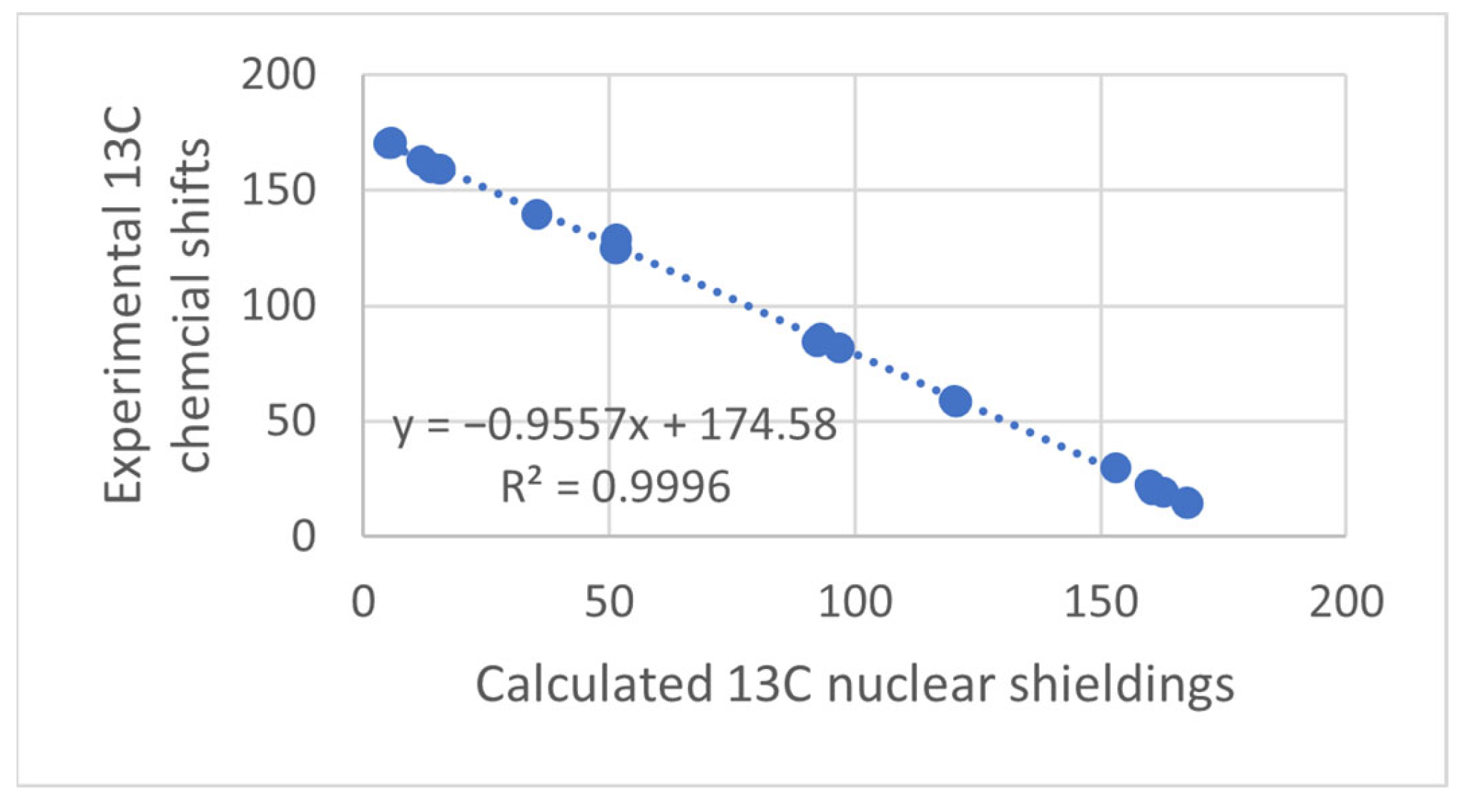

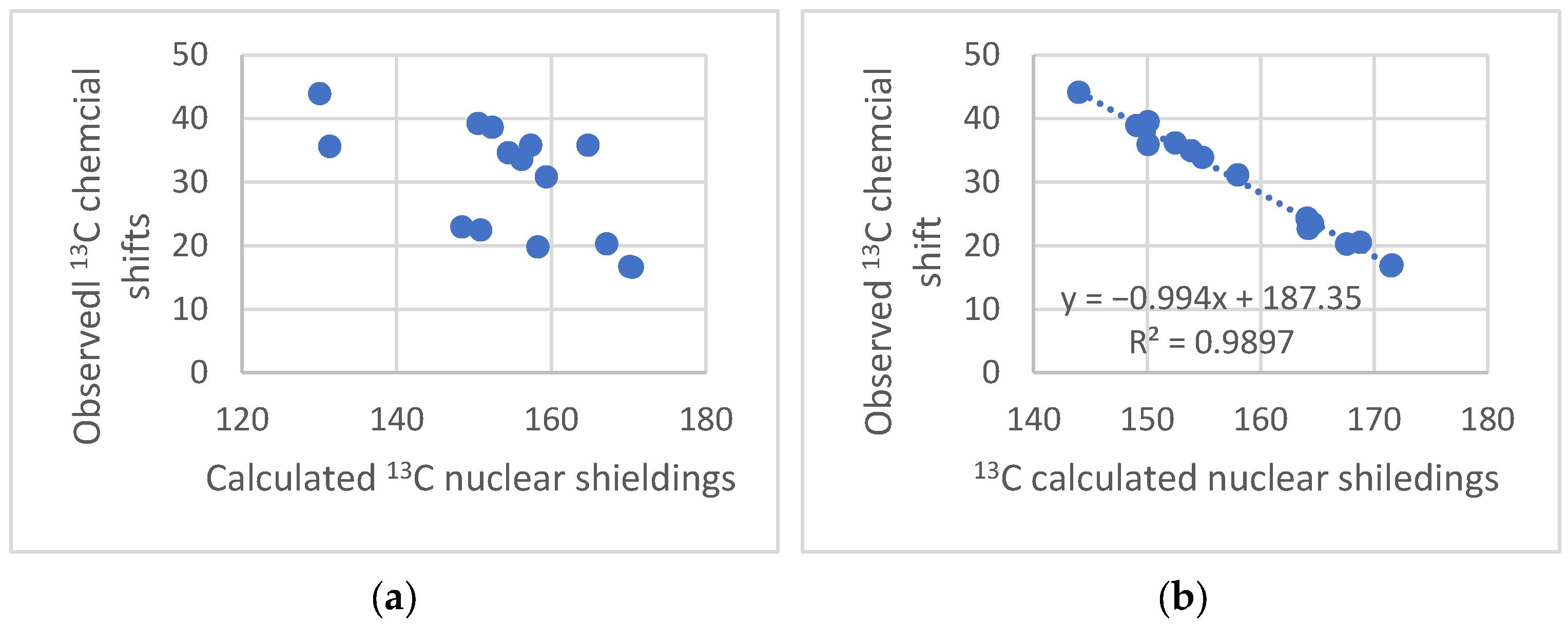




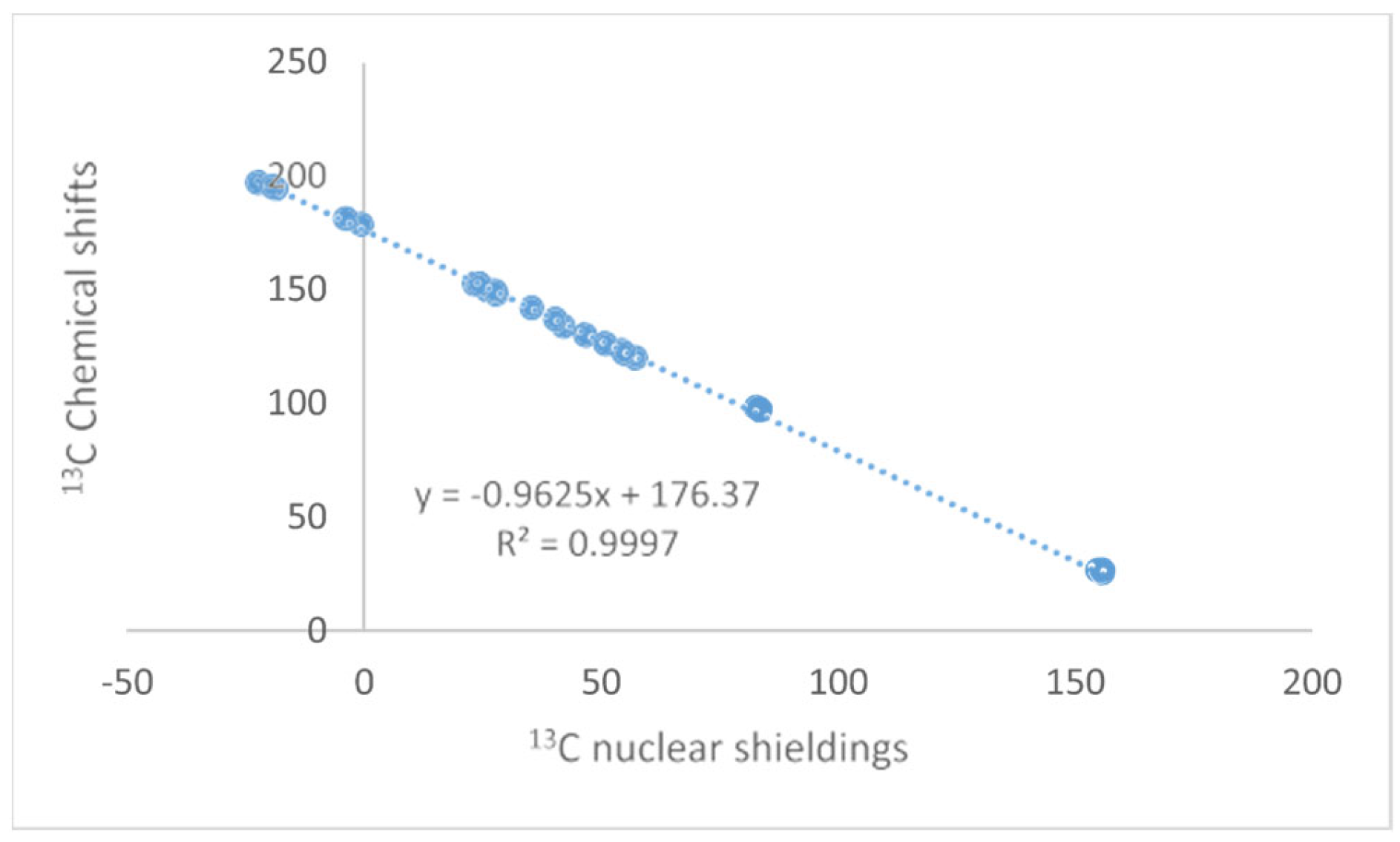
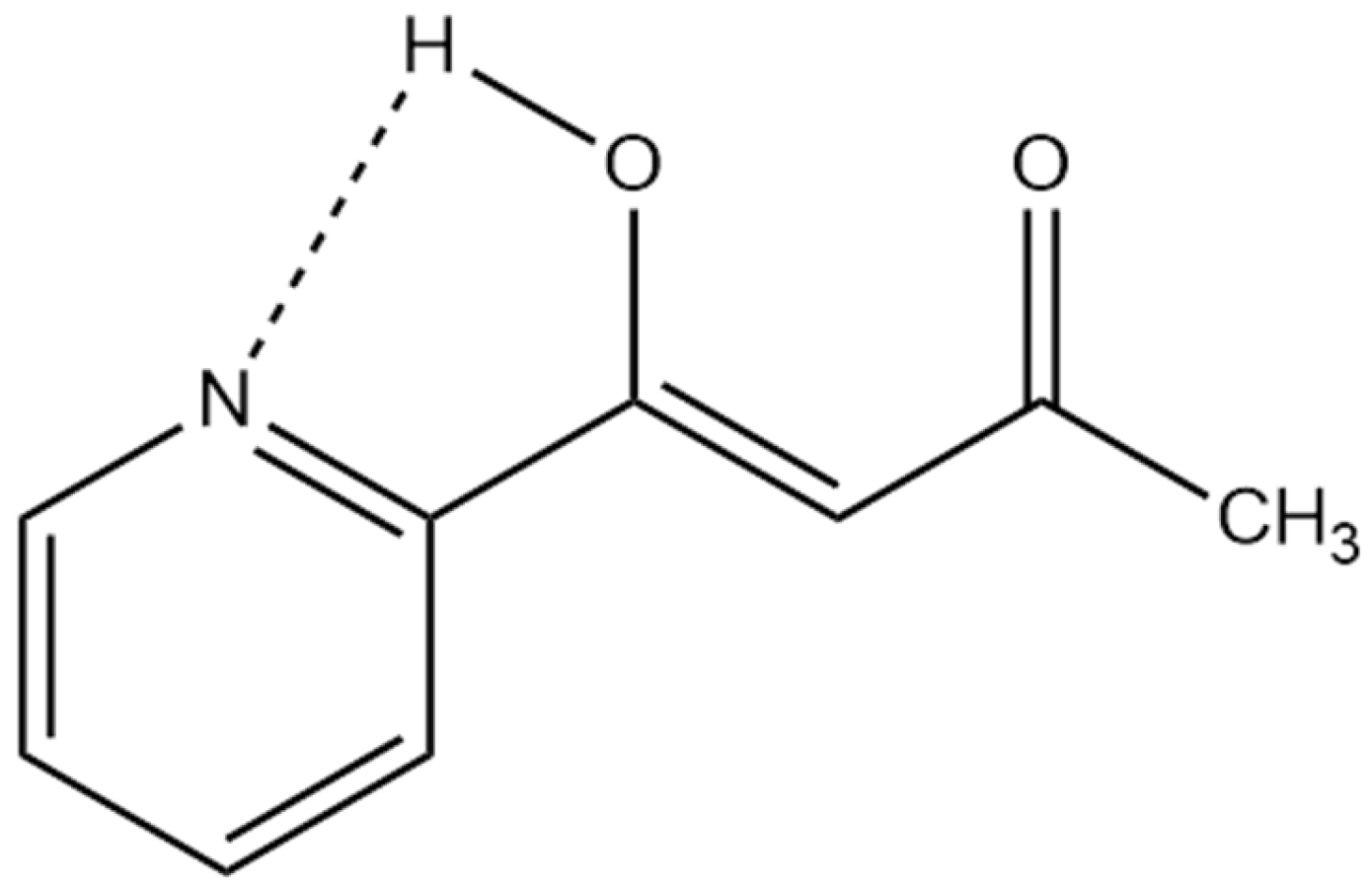

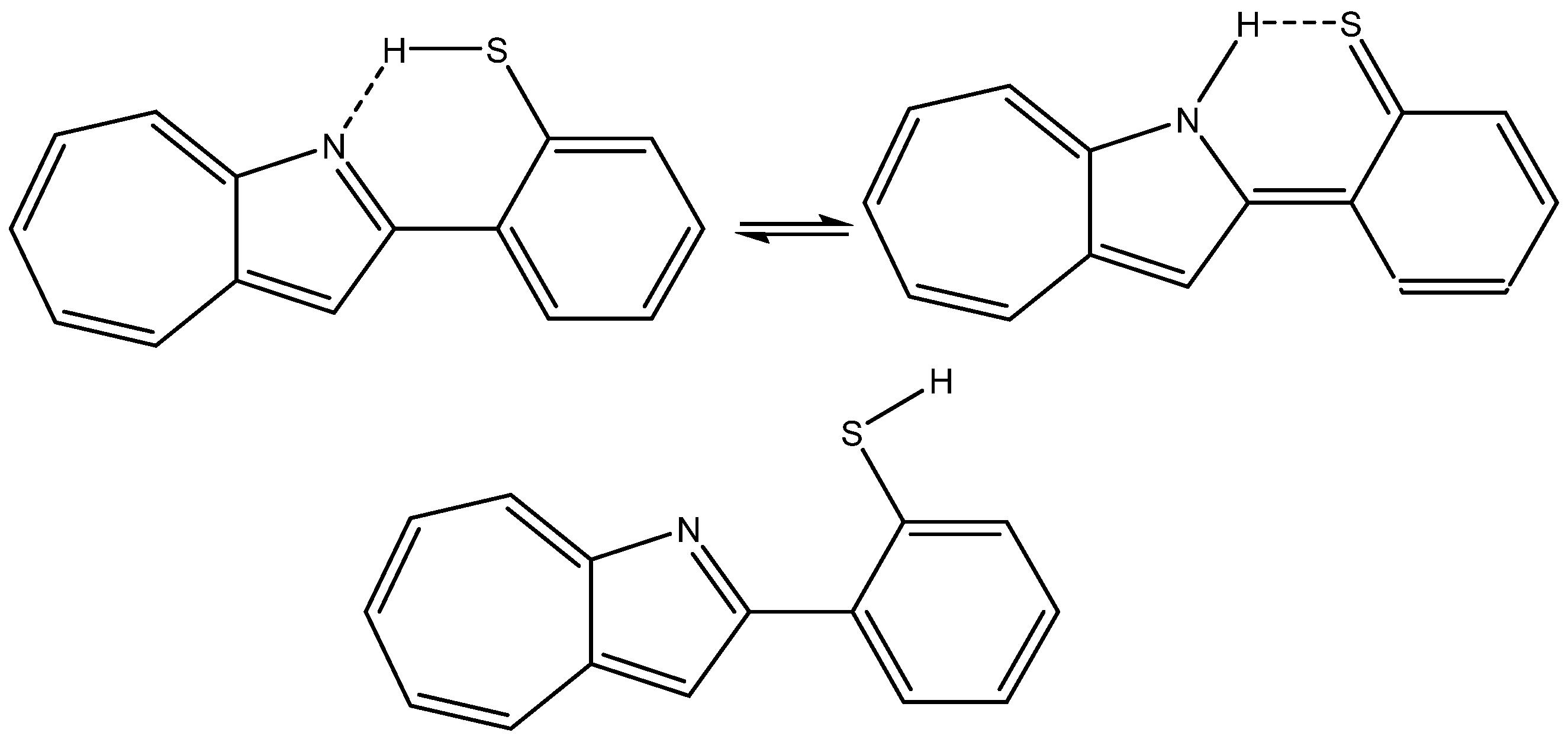

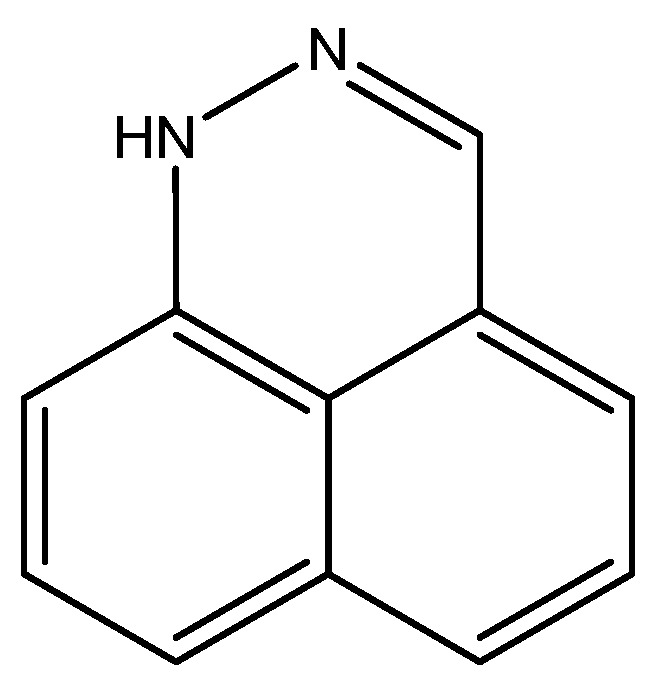

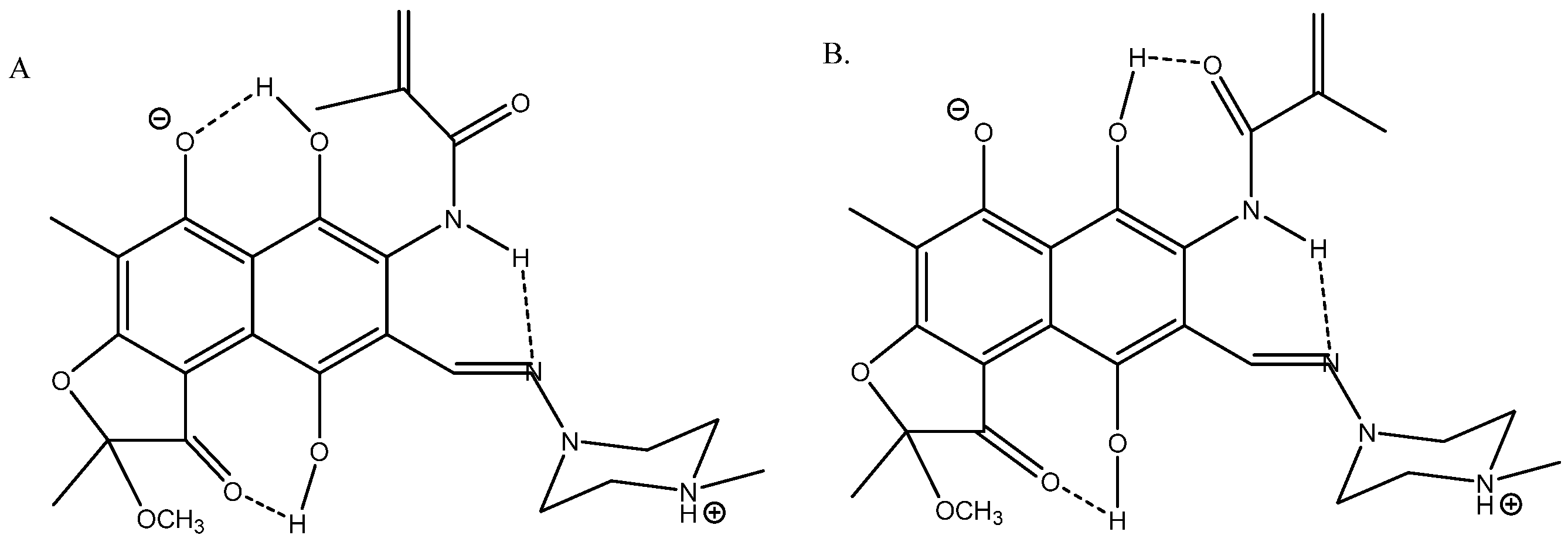





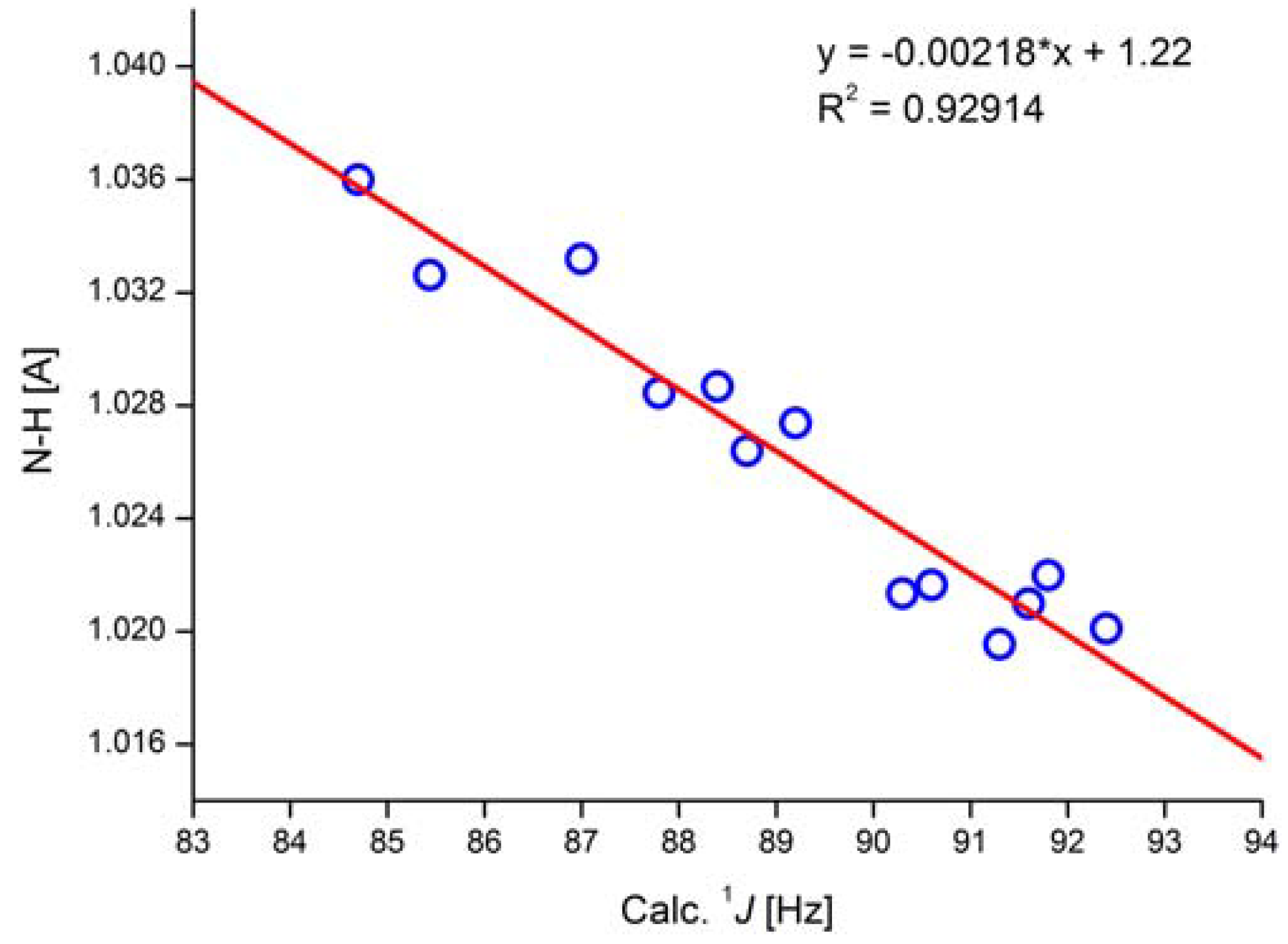
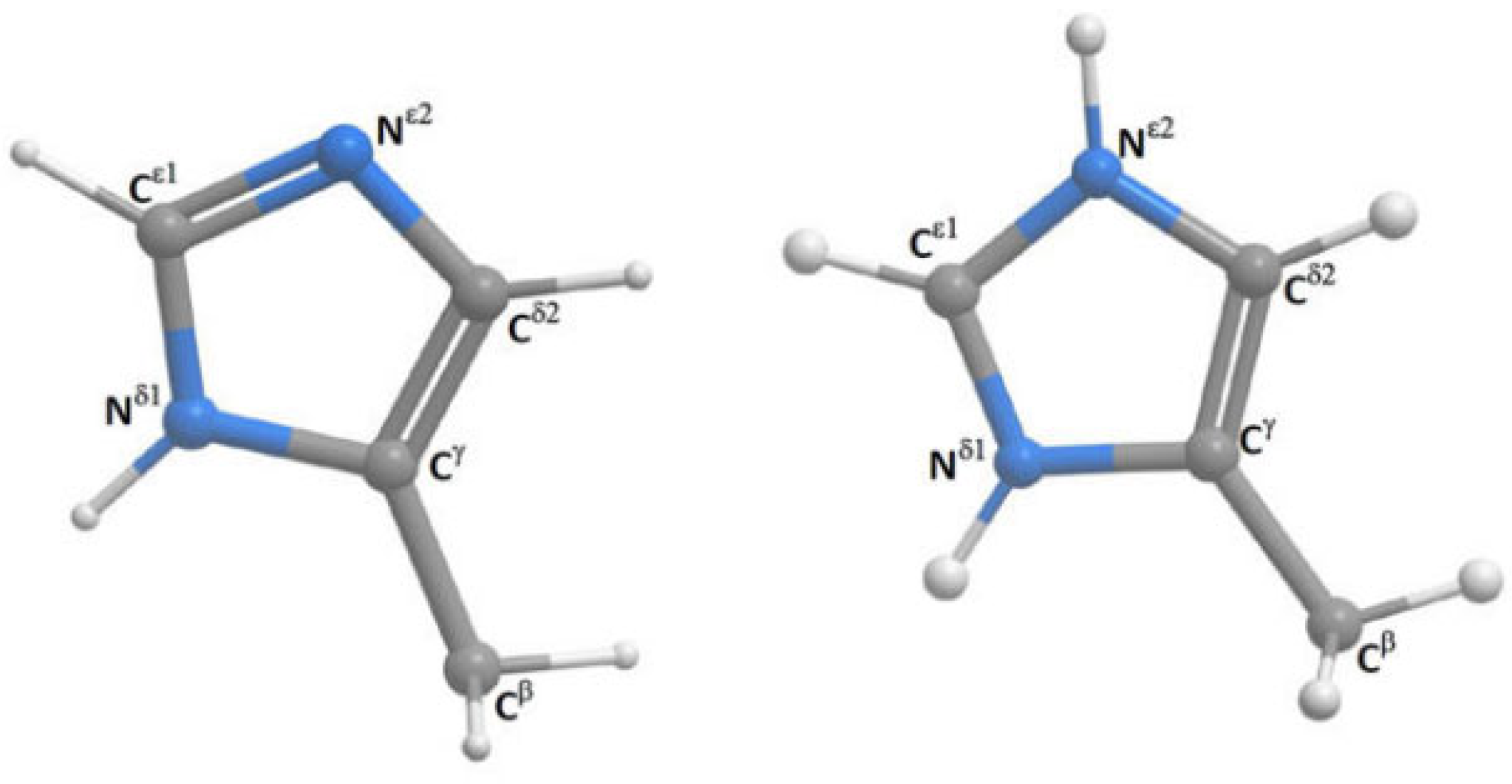

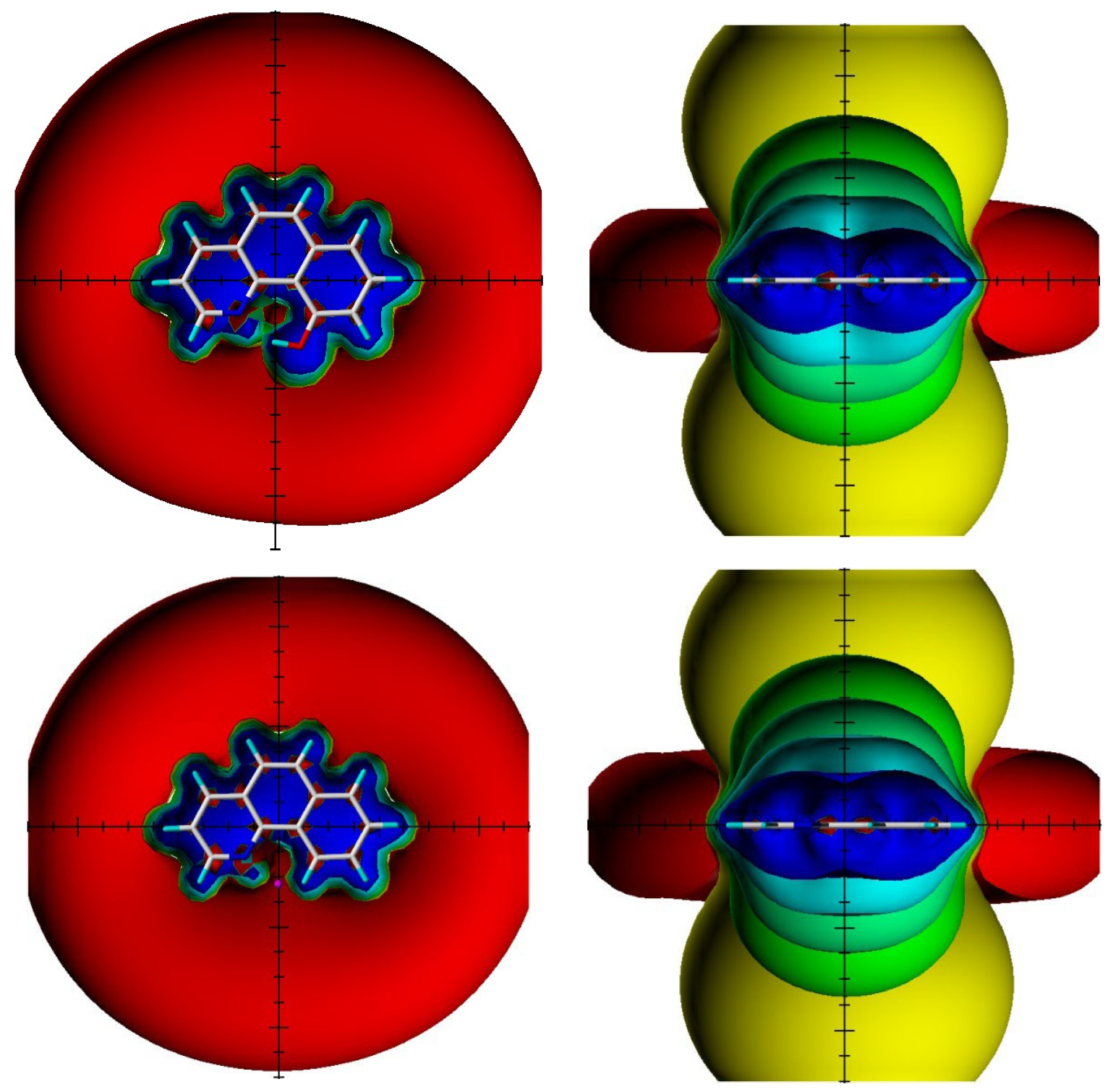
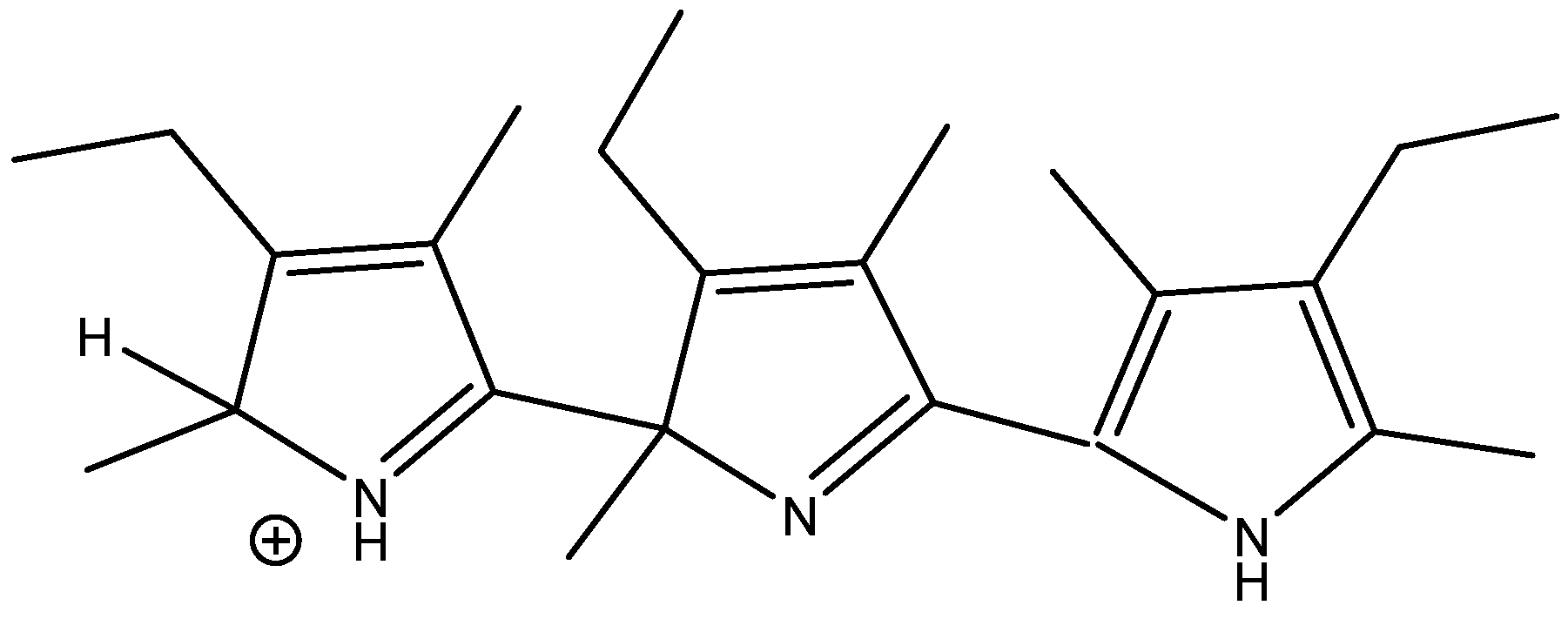



Disclaimer/Publisher’s Note: The statements, opinions and data contained in all publications are solely those of the individual author(s) and contributor(s) and not of MDPI and/or the editor(s). MDPI and/or the editor(s) disclaim responsibility for any injury to people or property resulting from any ideas, methods, instructions or products referred to in the content. |
© 2024 by the author. Licensee MDPI, Basel, Switzerland. This article is an open access article distributed under the terms and conditions of the Creative Commons Attribution (CC BY) license (https://creativecommons.org/licenses/by/4.0/).
Share and Cite
Hansen, P.E. The Synergy between Nuclear Magnetic Resonance and Density Functional Theory Calculations. Molecules 2024, 29, 336. https://doi.org/10.3390/molecules29020336
Hansen PE. The Synergy between Nuclear Magnetic Resonance and Density Functional Theory Calculations. Molecules. 2024; 29(2):336. https://doi.org/10.3390/molecules29020336
Chicago/Turabian StyleHansen, Poul Erik. 2024. "The Synergy between Nuclear Magnetic Resonance and Density Functional Theory Calculations" Molecules 29, no. 2: 336. https://doi.org/10.3390/molecules29020336
APA StyleHansen, P. E. (2024). The Synergy between Nuclear Magnetic Resonance and Density Functional Theory Calculations. Molecules, 29(2), 336. https://doi.org/10.3390/molecules29020336






